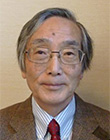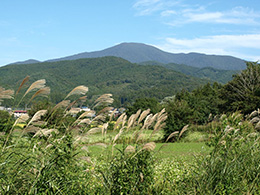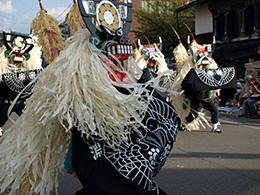Top>Research>Making people in urban areas shudder ―Spirit worlds and gods seen in The Legends of Tono
 Index
Index

Hideo Toguchi [profile]
Education Course
Making people in urban areas shudder
―Spirit worlds and gods seen in The Legends of Tono
Hideo Toguchi
Professor, Faculty of Commerce, Chuo University
Areas of Specialization: European Language Literature (research on tales centered around the Brothers Grimm)
Zashiki-warashi and Oshirasama
The Yamaguchi Magozaemon family in Tsuchibuchi-mura,Tono was prosperous. However, one night, after two Zashiki-warashi who brought in good fortune moved to another house, the family fell into ruin in a day. The family and servants died after eating poisoned mushrooms. The family possessions were swiftly taken away by relatives. Only the seven-year-old girl who happened to be out and didn’t eat the mushrooms survived (The Legends of Tono (hereafter Legends), Tales 18, 19).
A girl loved a horse, eventually to become its wife. The father, who was enraged at this absurdity, killed the horse, and the daughter rode the horse’s decapitated head to heaven. Then, to pray for their souls, an Oshira statue of the horse and daughter was created. This is one of the tales of the origin of Oshira (Legend 69). This god became the god of silkworm culture, god of eyes and god of women. Supplement 79 says this statue was dressed in red cloth during the Lunar New Year, with an old shrine maiden reciting the origin of the Oshira-kami and holding “Oshira games.” An old thatched Magariya has been reconstructed on the grounds of Denshoen Park in Tsuchibuchi. Leading to that is the Oshira-do Hall. Upon entering, you will be surprised by the countless number of Oshirasama. Figures of girls, horse heads and heads with headgear carved into about 30-centimeter-long mulberry branches and dressed in red or blue cloth are mounted on the wall. Visitors write a wish on the cloth and dress the figures.
Tsuchibuchi native Kizen Sasaki narrated numerous mysterious happenings of hometown, legends and beliefs to Kunio Yanagita, and Yanagita changed them to a refined literary style, edited them into 119 tales and published them in 1910 as The Legends of Tono. In 1935, an enlarged edition with further 299 tales (=supplements) was published.
Tono district

Mt. Rokkoushi from the mountain hamlet
The landscape of Tono district seen from Takashimizu Observation Deck is beautiful. The Sarugaishi River flows through the lush green fields of rice and other crops with a faint silver color shimmering. To the right is the central town of the region. Mountain hamlets are dotted around the town, and they are surrounded by mountains further out. Mt. Rokkoushi, one of the Tono three mountains, gently rises in the background in front of you. To the bottom left of that is the Fuefuki Pass. Further left is Mt. Sadato, and deep range of Mt. Shiromi, where that Mayoiga (phantom house which brings good fortune to visitors) is said to have appeared, stretches far. Mt. Hayachine, the highest peak in the Tono three mountains, cannot be seen from here.
The small basin Tono, surrounded by low-lying mountains, other than Mt. Hayachine, long served as a castle town for the Nanbu Domain, and prospered as an important point for trade between the coastal towns of Kamaishi and Otsuchi, and the inland Morioka and Hanamaki. In the days before the Iwate Keiben Railroad passed through the town, it was also a place where men carrying goods by horse, called dachin-tsuke, dropped in.
Closeness to the spirit world and the threat of nature
However, the Tono in the Legends is written about particularly harshness of people’s lives in the mountain hamlets, not prosperity of downtown locations. 2858 people in 1701 and 4300 people in 1755-56 died of starvation due to successive poor crops. There are also tales of houses being haunted by people sacrificed in order to ward off floods (Supplement 25, Legend 25). In the mountains, packs of wolves and bears attacked humans, and in Rokkoushi, people feared monster-like monkeys called Futtachi. There are also many tales of people being spirited away. Girls from Aozasa-mura and Kamigo-mura were snatched away. In Noboto, at the foot of Tengu Forest to the northwest of Tono, was the house of Old Lady in Samuto. When she was young, she suddenly disappeared, leaving her sandals at the base of a pear tree. 30 years later, when she had faded from memory, on a windy night when her family had gathered, she appeared in the similitude of becoming decrepit and ugly with age. She had come to see nostalgic friends. Then she left (Legend 8). Probably she had also been taken away by someone foreign, maybe a giant living in the mountains.
The mountains around Tono are deep. There are also Mayoiga in Mt. Shiromi (Legends 63, 64). In front of the villagers’ eyes, as if they were in a dream, a magnificent house appeared. However, when greedy people went in search of Mayoiga, it was nowhere to be seen. This may be one of the so-called hidden village legends. The legends say that in the same mountain, a girl was seen running away at night, and that “a girl with two long pigtails” peeked into a charcoal burnt house in Hanaremori-wood next to that mountain. The legend also states that “it is not rare to hear a girl wailing in the middle of the night” in this district.
Villagers were frightened at the mountains where long-nosed goblins, giants and mountain witches were rampant. In Legend 5 it says that because, in recent years, people were certain to come across giants and mountain witches on the Fuefuki Pass that headed for Otsuchi on the coast, a road crossing the Sakaige Pass was built. However, the mountain gods were even more frightening. In the mountains of Ayaori-mura, a man who drew a knife and slashed at a red-faced mountain god was kicked unconscious by the god and died three days later. This was only “a little over ten years ago.” (Legend 91)
The deceased as a familiar existence
It was in this manner that the mountain hamlets became connected to the spirit world. Numerous supernatural phenomena are recorded in Legends. There are tales of people appearing in another place when they die (Legends 86-88). There are also various tales of omens and near-death experiences informing people of death. There are also tales of dead family members showing themselves (Legends 22, 23). And, what has been continually quoted after the massive tsunami in 2011 was Legend 99. A man called Fukuji, who lost his wife in the 1896 Sanriku tsunami, met the ghost of his late wife in the Funakoshi seaside in the middle of the night. However, she was with a man from the same village who had also perished in the tsunami, someone the wife was attracted to before they were married. Fukuji saw the two married as ghosts and became ill for a while.
Located between private houses at the entrance to the mountains are Dendera-no and Dannohana, both on small hills. Whenever I visit Tono, I always go to Dendera-no. This was the place where seniors over sixty were abandoned. The humble straw hut where these people lived has also been restored here. From here, looking down on the houses of the village and over to the mountains in the back, I wonder what kind of thoughts the elderly had when they lived here. While they were healthy they would have helped with work in the fields below and then returned here in the evening. They would have been able to stoke fires in the huts, but even so, how did the elderly survive through the cold of Tono's harsh winters? They were most likely waiting patiently for the day when they would be buried at Dannohana (a communal burial site). And, one day, they would become ancestral spirits and stay at Mt. Hayachine, and then return to their nostalgic homes during the Bon Festival.
Legends tell the world in which life and death continue. While the two are of different nature, humans can go back and forth between them. The deceased clearly exist in the memories of the living and the thoughts of the deceased are restored in the living. In a way, that is a consoling world picture. There we can see a circle of time where life does not end with death.
Living with pious feelings towards the gods

Tono Festival deer dance
Exposed to the threats of nature, the people surrounded by the spiritual world fostered a diverse range of beliefs. In addition to the ancient religions of Buddhism, Shinto and Shugendo, there were mountain gods, water gods, rice field gods, Okunaisama, Gongesama, Konseisama, Oshirasama, Zashiki-warashi and more.
There are indeed a lot of stone monuments in this area. The simple monuments along the streets of Hiwatari, or the group of mountain gods stone monuments by the small shrine dedicated to Unedorisama, the god of marriage. Nearby, 500 natural stones are in the deep mountains. A priest called Gizan carved Arhat on the 500 stones, which are 500 disciples of the Buddha, while chanting a Buddhist prayer for the repose of starvation victims in the Tenmei era. In Tono, the gods, people and nature (animals, forests, water, stones, etc.), taking root in the history of animism, had a deep relationship.
I went to the Tono Festival last autumn. Along with the elegant kagura (sacred music and dance), as a Shinto ritual, and the deer dance, which was written in Yanagita's introduction, girls in beautifully colored kimono danced to Nambu-bayashi (a kind of festival music in the southern region) and the local Sansa-odori. Many slightly different dances, depending on the region, were performed over two days. No stone was left unturned in communicating the richness of the town cultural heritage.
Why now The Legends of Tono?
In the Meiji era when this book was written, Japan was in the movement of a strong westernization, and traditional customs and beliefs had become to be seen as old-fashioned. The following story explains those circumstances.
There was a person who prepared baths using the water that sprang from a swamp in Aozasa-mura that was said to be good for the body, and have many sick people enter them. When there were an overwhelming number of people trying to get benefits, a police officer insisted that it was a superstition that did more harm than good to the progress of the times. As a sign of rebuke, he kicked and trampled on the small shrine next to him. “In doing so, on his way home he became unable to use his arms and legs freely, and when he got home he passed away. Family members also became sick, some also dying. This is believed to be a story from the early Meiji era.” (Supplement 43)
Yanagita wrote this in the introduction of his book. “I hope that telling these tales will make people in urban areas shudder.” In the dedication in the beginning he writes, “I offer this book to those in foreign lands.” Going back to the Jomon Period, the prototype of the lives of Japanese was conducted in deep nature, and the “people in urban areas,” who lost the water veins flowing continuously in their souls, are now “in a foreign land.” Transcendent views have been lost due to the results of science and technology, and it could be further said that Yanagita contrasted the arrogant ideas of modern people who believed they could control nature with the following words from Hamlet. “There are more things in heaven and earth than are dreamt of in your philosophy.” The human world is so profound.
Texts and Reference Materials
Kunio Yanagita: The Legends of Tono (with supplements) (Kadokawa Sophia Bunko)
Masami Ishii: Understanding “The Legends of Tono” (Heibonsha Shinsho)
- Hideo Toguchi
Professor, Faculty of Commerce, Chuo University
Areas of Specialization: European Language Literature (research on tales centered around the Brothers Grimm) - Hideo Toguchi was born in Gunma Prefecture in 1946. He graduated from International Christian University in 1969. He completed the Master’s degree (Master of Literature) in 1971 at Tokyo Metropolitan University. He became an assistant professor at Chuo University since 1978 after working as an assistant professor at the Faculty of Humanities and Economics, Kochi University. He has been a professor since 1986 and became a visiting researcher at the University of Vienna from 1988 to 89. He majors in 19th-20th century German literature and Viennese culture. His recent research has been focused on fairy tales, especially the Brothers Grimm. Major publications include Seinaru Mono To Souzouryoku (Sacred Objects and the Imagination), (coauthor, Sairyusha, 1994), and Wien Sono Shirarezaru Shosou (Vienna: Unknown Aspects), (coauthor, Chuo University Press, 2000). Translations include Heinrich Schipperges’ Hildegard of Bingen (co-translator, Kyobunkwan, 2002), and Anton Rieder’s Forests of Vienna –Nature, Culture, History– (Nansosha, 2007).
- Research Activities as a Member of Research Fellowship for Young Scientists (DC1), Japan Society for the Promotion of Science (JSPS) Shuma Tsurumi
- Important Factors for Innovation in Payment Services Nobuhiko Sugiura
- Beyond the Concepts of Fellow Citizens and Foreigners— To Achieve SDGs Goal 10 “Reduce Inequality Within and Among Countries” Rika Lee
- Diary of Struggles in Cambodia Fumie Fukuoka
- How Can We Measure Learning Ability?
—Analysis of a Competency Self-Assessment Questionnaire— Yu Saito / Yoko Neha - The Making of the Movie Kirakira Megane








